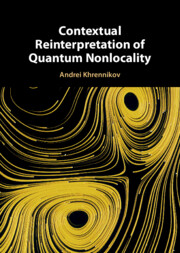Book contents
- Frontmatter
- Dedication
- Contents
- Preface
- Acknowledgments and Recollections
- 1 Introduction to Quantum Measurement Theory
- Part I Quantum Foundations
- Part II Bell Inequalities
- Part III Contextuality: Mathematical Modeling and Interpretation
- Part IV Contextual Entanglement in Quantum and Classical Physics
- Part V Hertz, Boltzmann, Schrödinger, and de Broglie on Hidden Parameters
- 15 Bild Conception for Scientific Theory
- 16 Prequantum Classical Statistical Field Theory (PCSFT)
- Part VI Further Developments
- References
- Index
15 - Bild Conception for Scientific Theory
from Part V - Hertz, Boltzmann, Schrödinger, and de Broglie on Hidden Parameters
Published online by Cambridge University Press: 28 November 2024
- Frontmatter
- Dedication
- Contents
- Preface
- Acknowledgments and Recollections
- 1 Introduction to Quantum Measurement Theory
- Part I Quantum Foundations
- Part II Bell Inequalities
- Part III Contextuality: Mathematical Modeling and Interpretation
- Part IV Contextual Entanglement in Quantum and Classical Physics
- Part V Hertz, Boltzmann, Schrödinger, and de Broglie on Hidden Parameters
- 15 Bild Conception for Scientific Theory
- 16 Prequantum Classical Statistical Field Theory (PCSFT)
- Part VI Further Developments
- References
- Index
Summary
In this chapter we start with methodological analysis of the notion of scientifictheory and its interrelation with reality. This analysis is based onthe works of Helmholtz, Hertz, Boltzmann, and Schrödinger (and reviewsof D’ Agostino). Following Helmholtz, Hertz established the “Bild concept”for scientific theories. Here “Bild” (“picture”) carries the meaning “model”(mathematical). The main aim of natural sciences is construction of thecausal theoretical models (CTMs) of natural phenomena. Hertz claimed thatCTM cannot be designed solely on the basis of observational data; it typicallycontains hidden quantities. Experimental data can be described by anobservational model (OM), often at the price of acausality. CTM-OM interrelationcan be tricky. Schrödinger used the Bild concept to create CTM forquantum mechanics (QM) and QM was treated as OM. We follow him andsuggest a special CTM for QM, the so-called prequantum classical statisticalfield theory (PCSFT). QM can be considered as a PCSFT-image, but notas straightforward as in Bell’s model with hidden variables. The commoninterpretation of the violation of the Bell inequality is criticized from theperspective of the two-level structuring of scientific theories.
- Type
- Chapter
- Information
- Contextual Reinterpretation of Quantum Nonlocality , pp. 195 - 223Publisher: Cambridge University PressPrint publication year: 2024

